Key takeaways:
- Mindfulness meditation encourages present-moment awareness and non-judgmental observation of thoughts and sensations.
- Regular practice can enhance emotional resilience, improve mental and physical health, and promote better sleep quality.
- Incorporating mindfulness into daily routines and creating dedicated moments can transform routine tasks into enriching experiences.
- Overcoming challenges such as distractions and impatience is essential for establishing a sustainable mindfulness practice.
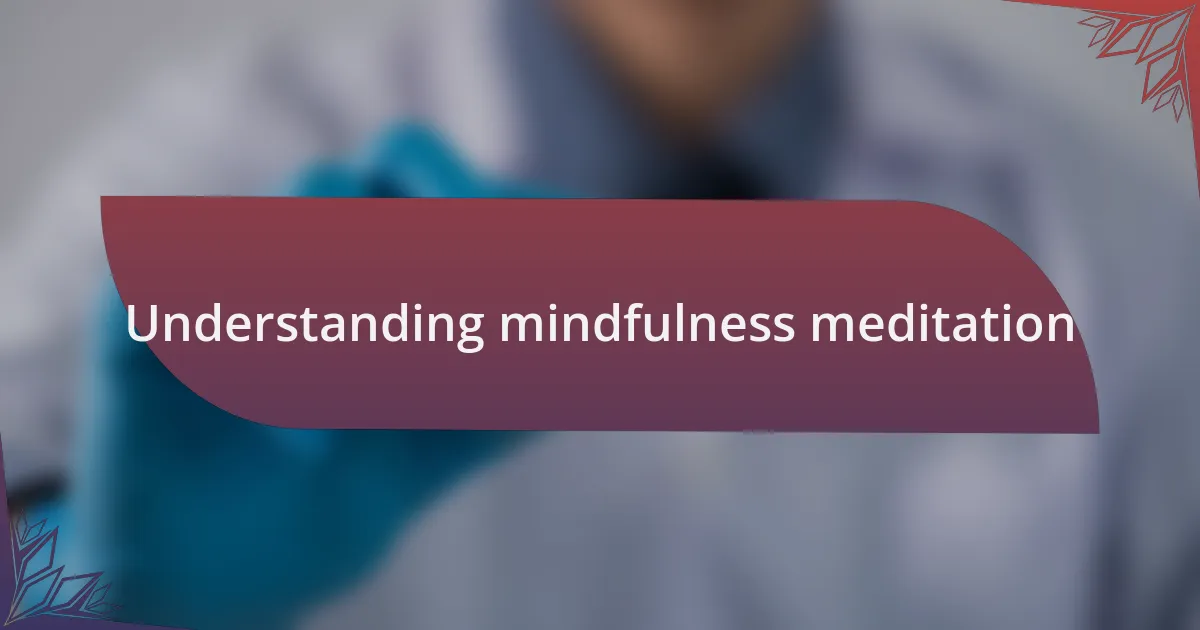
Understanding mindfulness meditation
Mindfulness meditation is a practice that encourages you to focus fully on the present moment. I remember the first time I tried it; I felt an overwhelming sense of awareness creeping in, almost as if I were seeing the world anew. What a revelation it was to realize that I could quiet the noise of my racing thoughts, even if just for a few minutes!
At its core, mindfulness is about observing thoughts and sensations without judgment. I often find myself reflecting on this non-reactive space; it’s as though I’m watching clouds drift by while sitting on the shore. Isn’t it fascinating how such a simple act can lead to profound emotional insights and a deeper connection with oneself?
The beauty of mindfulness meditation lies in its accessibility. Regardless of your background or experience, you can start to cultivate this practice right now, perhaps by taking a few deep breaths. How often do we overlook the value of just being? Engaging in mindfulness can transform the mundane into something extraordinary and help us navigate the complexities of life with a little more grace and understanding.
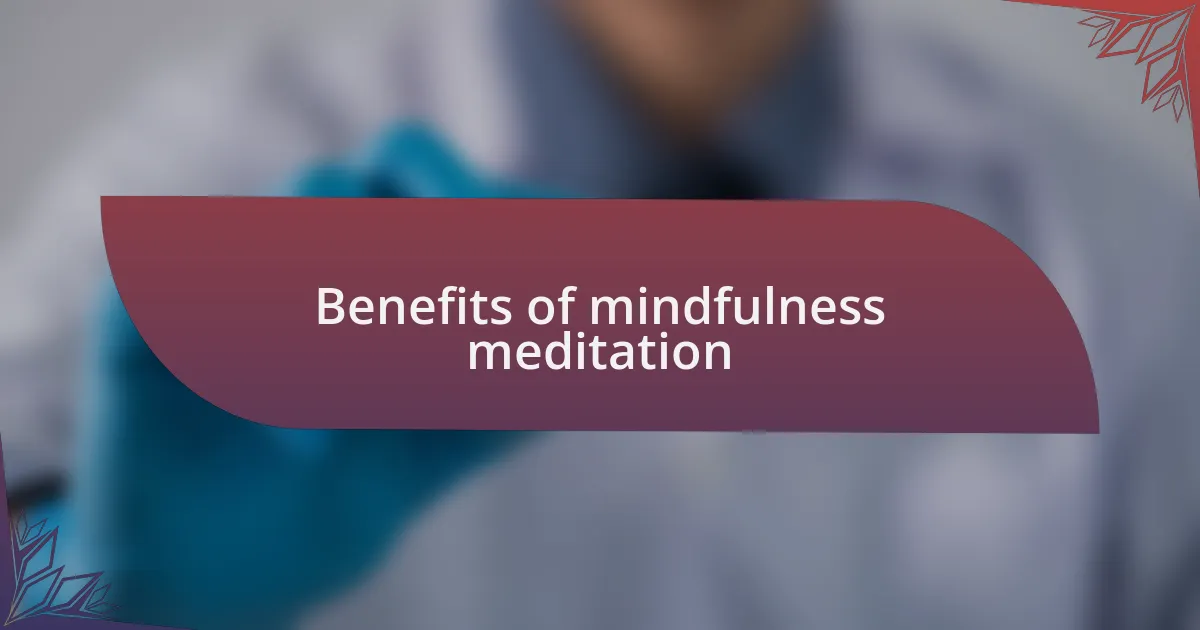
Benefits of mindfulness meditation
Mindfulness meditation offers a myriad of benefits that extend beyond the immediate calm it provides. I vividly recall how, during particularly stressful weeks, carving out just ten minutes for meditation made a significant difference in my overall mood. It felt as if my mind was a tangled mess of yarn, and with each breath, I gently unraveled the strands, leading to clearer thoughts and improved focus.
What surprised me the most was how this practice fostered emotional resilience. I once faced a challenging situation where I felt overwhelmed, but by simply taking a moment to ground myself through mindfulness, I noticed my reactions became more measured. Isn’t it amazing how a few minutes of stillness can create space for more thoughtful responses rather than knee-jerk reactions?
Additionally, research suggests that regular mindfulness meditation can enhance physical health by reducing stress-related symptoms. I experienced this firsthand when I noticed my sleep quality improving significantly after I stocked my evening routine with mindfulness techniques. Who would have thought that just a small shift in focus could lead to better rest and a revitalized sense of well-being? Mindfulness meditation truly is a powerful ally in our journey towards a healthier life.
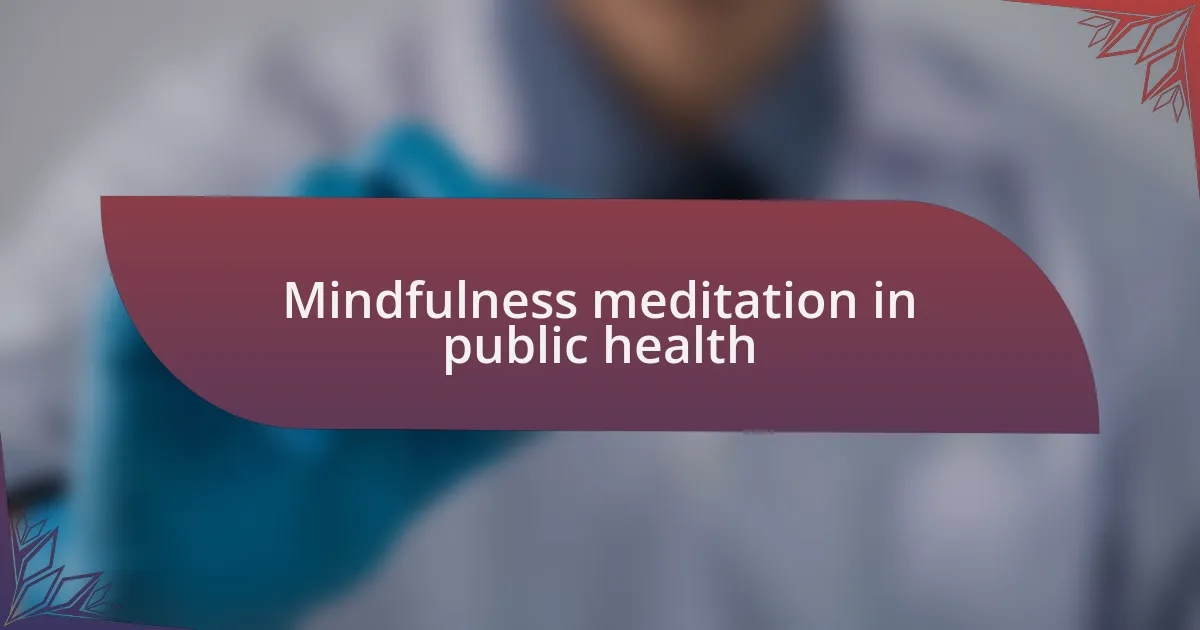
Mindfulness meditation in public health
Mindfulness meditation holds a unique place in public health, particularly when it comes to addressing the escalating issues of stress and anxiety in our fast-paced world. I’ve noticed how even brief moments of meditation in community workshops can lead to palpable changes in participants’ demeanor, as if they’ve stepped out of a fog. Have you ever observed how a group becomes more cohesive and supportive after engaging in a simple mindfulness session?
What’s intriguing is its role in enhancing mental health resources. In my experience with various health initiatives, integrating mindfulness programs not only improved participant engagement but also fostered a shared sense of calm in high-stress environments like hospitals or schools. Isn’t it fascinating how such a straightforward practice can bridge gaps between different groups and create a more inclusive atmosphere?
Moreover, there’s compelling evidence linking mindfulness meditation to improved public health outcomes, especially in mental well-being. I once facilitated a program where we encouraged individuals to incorporate mindfulness into their daily routines, and the feedback was overwhelmingly positive. The participants reported feeling more centered and less reactive, showing just how impactful mindfulness can be on a community level. Isn’t it remarkable how something that requires so little time can result in such profound change?
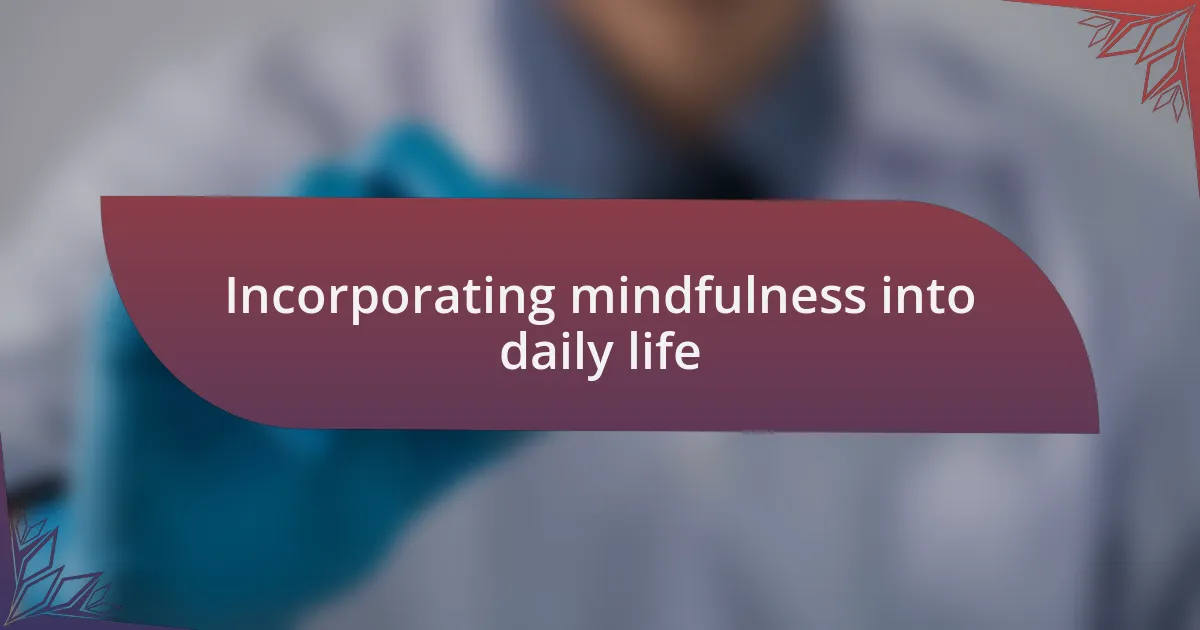
Incorporating mindfulness into daily life
Finding ways to weave mindfulness into everyday routines can be transformative. I often suggest starting small; for instance, taking just five minutes in the morning to breathe deeply and set intentions can create a ripple effect throughout the day. Have you ever noticed how a little bit of focused breathing can shift your mood from chaotic to calm?
In my daily life, I try to infuse mindfulness during mundane tasks, like washing dishes or commuting. As I scrub the plates or navigate traffic, I focus on the sensations and sounds around me rather than letting my mind drift to what’s next on my agenda. It’s such a simple shift, but I find that it makes the routine feel more enriching and less like a chore. Can you relate to discovering little pockets of peace in your day?
Creating dedicated mindfulness moments can deepen our connection to the present. When I engage in a brief mindfulness break at work, my energy levels often surge, leaving me more productive and focused. I’ve even encouraged friends to step outside for just a minute to take in their surroundings. These moments remind me that mindfulness doesn’t have to be a lengthy commitment; it can be seamlessly integrated into our lives, leaving us all the better for it.
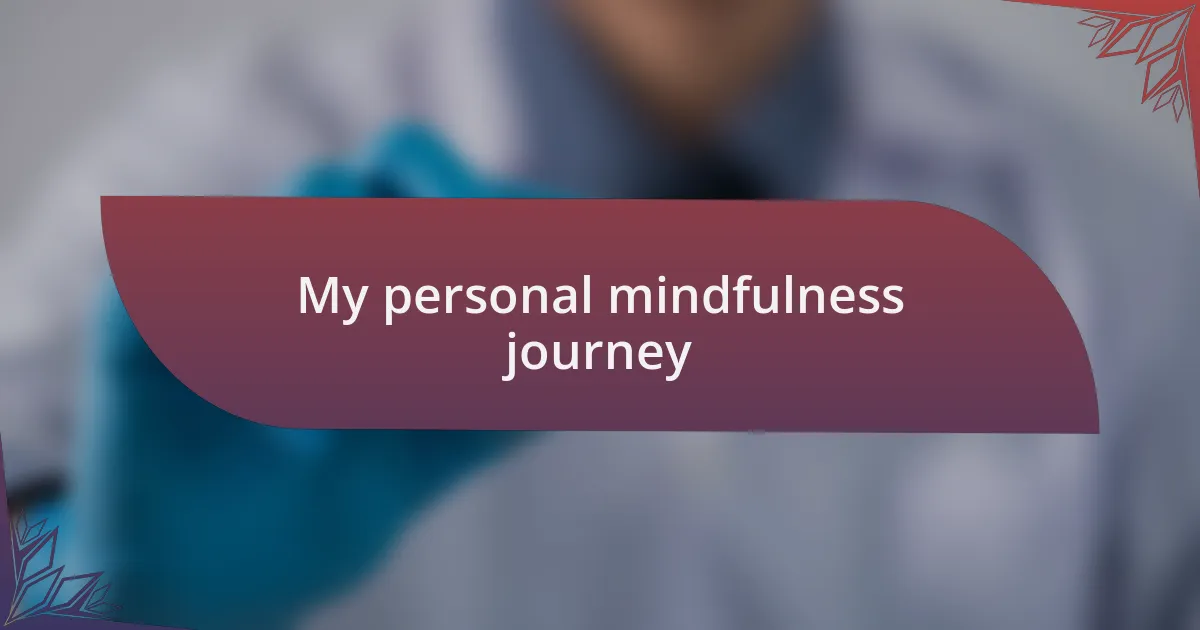
My personal mindfulness journey
My personal mindfulness journey has been an evolving experience that started quite unexpectedly. I remember one afternoon, feeling overwhelmed and on the verge of burnout. In a moment of desperation, I decided to try a guided meditation app. That first session was eye-opening—I finally found stillness amid my chaos. Have you ever felt that sense of clarity wash over you?
As I continued my practice, I made it a point to reflect on my emotions at the end of each meditation. One day, I was struck by how often I rushed through my feelings, labeling them as “good” or “bad” without truly acknowledging them. This realization compelled me to lean into discomfort rather than shy away. Isn’t it fascinating how embracing our vulnerability can lead to profound growth?
I’ve also found that being mindful during walks has enhanced my appreciation for nature. While enjoying the crunch of leaves underfoot, I become acutely aware of the fresh air and shifting light. I often catch myself smiling for no reason, simply savoring the moment. Does it ever amaze you how the simplest things can spark such joy when we take the time to notice?
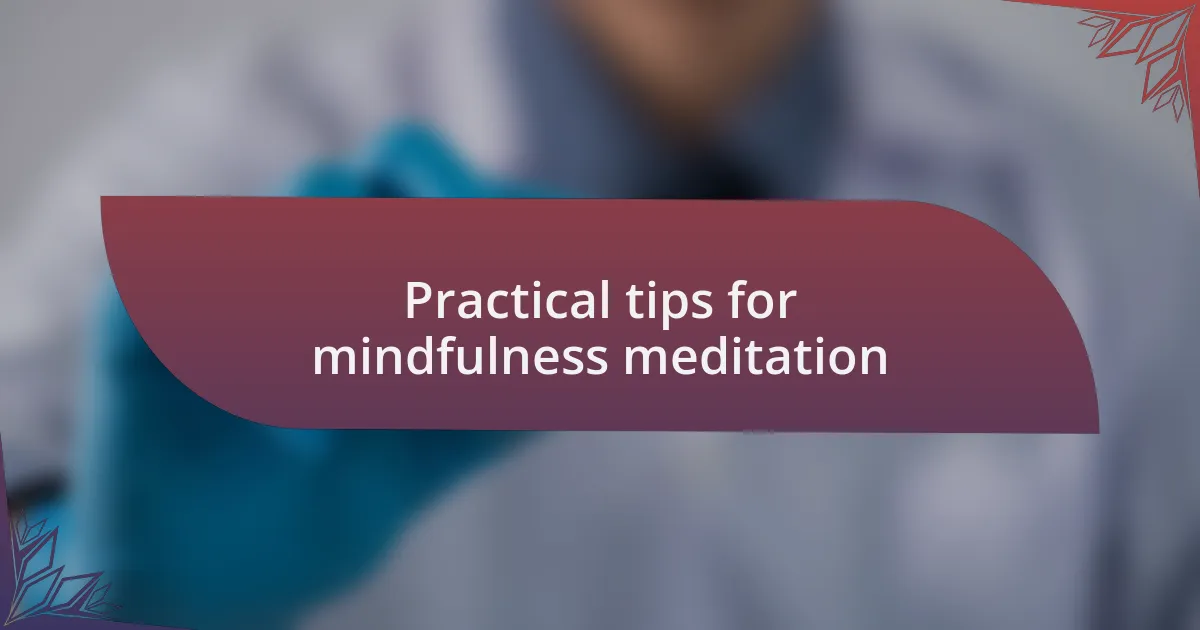
Practical tips for mindfulness meditation
When starting your mindfulness meditation practice, find a quiet space where interruptions are minimal. I recall one afternoon, transforming my cluttered kitchen table into a peaceful retreat with just a cozy cushion and some soft lighting. It may sound simple, but creating a designated spot makes it easier to settle into that tranquil mindset. Have you ever noticed how your environment can influence your state of mind?
Another practical tip is to start small. Initially, I committed to just five minutes a day and gradually increased the duration as I became more comfortable. This approach not only eased me into the practice but also reinforced that mindfulness doesn’t have to be a daunting task. Can you think of a time when taking baby steps led to unexpected progress?
Incorporating breath awareness can significantly enhance your experience. Personally, I’ve found that focusing on my inhale and exhale establishes a calming rhythm, grounding me in the present moment. Each breath serves as a gentle reminder that I’m here, now. When was the last time you truly tuned in to the rhythm of your breathing?
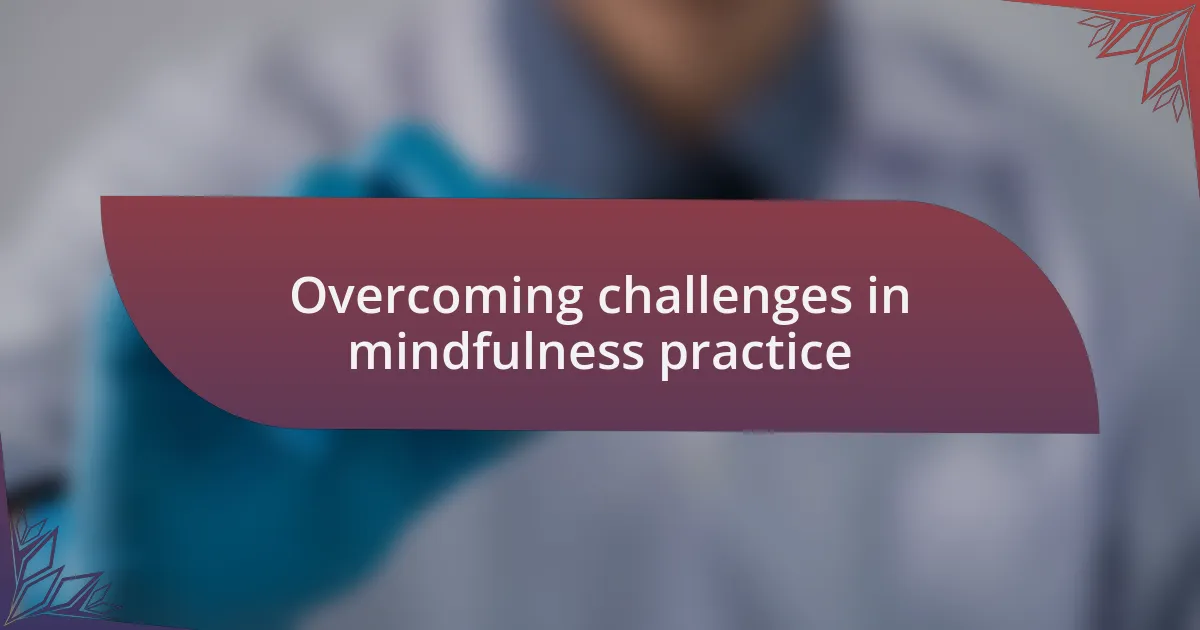
Overcoming challenges in mindfulness practice
Mindfulness practice often presents challenges, especially with persistent distractions. I remember one session where thoughts of my to-do list kept invading my mind. It was frustrating, but I learned an important lesson: rather than battling these distractions, it’s more effective to acknowledge them and gently redirect my focus back to my breath. Have you experienced a similar struggle during your practice?
Another hurdle can be cultivating patience. I used to get impatient when I didn’t see immediate results. It took time for me to realize that mindfulness is less about achieving a specific state and more about the journey itself. One moment spent fully present is just as valuable as a lengthy meditation session. How has your practice evolved in this regard?
Creating a routine is crucial for overcoming these challenges. I began setting a specific time each day for my practice, which transformed mindfulness into a non-negotiable part of my life. As I embraced this consistency, I discovered that it’s easier to face those challenges when I know I’m committed. Have you found a routine that works for you?